AT LEAST 12 THINGS TO SEE (AND DO) AT PISA - With Google Maps link to reach every place
 When we think of Pisa we refer to its leaning tower, but it is only one of the many monuments and places to visit offered by the beautiful Tuscan city. The famous Piazza del Duomo contains, in a complex unique in the world and precisely for this reason defined the 'Campo dei Miracoli', the main monuments of the city: the Tower, the Duomo, the Baptistery and the Campo Santo.
When we think of Pisa we refer to its leaning tower, but it is only one of the many monuments and places to visit offered by the beautiful Tuscan city. The famous Piazza del Duomo contains, in a complex unique in the world and precisely for this reason defined the 'Campo dei Miracoli', the main monuments of the city: the Tower, the Duomo, the Baptistery and the Campo Santo.
Moving slightly, however, you can discover other artistic wonders that make it one of the most beautiful cities of art in Italy.
Buildings, monuments and museums contribute to keeping alive the memory of a past in which Pisa was a Maritime Republic and undisputed Mediterranean and commercial mistress (with particular reference to the Crusades in the Holy Land).
1) The Leaning Tower of Pisa
 Emblem of the city of Pisa due to its characteristic slope, the Tower is the most famous monument of Piazza del Duomo. Built between the 12th and 14th centuries, the Tower hangs because the land has already given way in the early stages of construction and has remained so since then thanks to complex consolidation systems. The Tower of Pisa has been proposed as one of the seven wonders of the modern world, to visit it is recommended to book tickets online in advance.
Emblem of the city of Pisa due to its characteristic slope, the Tower is the most famous monument of Piazza del Duomo. Built between the 12th and 14th centuries, the Tower hangs because the land has already given way in the early stages of construction and has remained so since then thanks to complex consolidation systems. The Tower of Pisa has been proposed as one of the seven wonders of the modern world, to visit it is recommended to book tickets online in advance.
Address: Piazza del Duomo, 56126 Pisa PI
Tickets: Tiqets.com
2) The Cathedral of Santa Maria Assunta in Pisa
 The Cathedral of Pisa is dedicated to Santa Maria Assunta and is a significant example of Romanesque art. It was designed by the architect Buscheto merging elements of Norman, Byzantine and early Christian art, anticipating the Florentine Renaissance. Its construction began in 1064, coinciding with the Basilica of San Marco in Venice, in a sort of competition for the most beautiful and majestic place.
The Cathedral of Pisa is dedicated to Santa Maria Assunta and is a significant example of Romanesque art. It was designed by the architect Buscheto merging elements of Norman, Byzantine and early Christian art, anticipating the Florentine Renaissance. Its construction began in 1064, coinciding with the Basilica of San Marco in Venice, in a sort of competition for the most beautiful and majestic place.
Address: Piazza del Duomo, 56126 Pisa PI
3) The Baptistery of Pisa
 Also in Piazza del Duomo it is possible to appreciate the Baptistery, whose construction began in 1153. The largest baptistery in Italy was designed by the architect Diotisalvi. The external dome covers only the inner circle of the pillars and probably due to the lack of money is made up of different materials (red tiles and lead plates); for the same reason the ceiling does not have all the frescoes foreseen in the original project.
Also in Piazza del Duomo it is possible to appreciate the Baptistery, whose construction began in 1153. The largest baptistery in Italy was designed by the architect Diotisalvi. The external dome covers only the inner circle of the pillars and probably due to the lack of money is made up of different materials (red tiles and lead plates); for the same reason the ceiling does not have all the frescoes foreseen in the original project.
Address: Piazza del Duomo, 56126 Pisa PI
4) The Camposanto Monumentale of Pisa
 The last wonder of the 'Campo dei Miracoli' is the Monumental Cemetery, a sacred place because the crusaders brought here the holy land taken on Mount Golgotha, located near Jerusalem. Here the most illustrious characters are buried together with works of art from various periods including the Etruscan, Roman and medieval ages. The bombings of the Second World War caused damage to the frescoes and then the laborious restoration work began, partially still in progress.
The last wonder of the 'Campo dei Miracoli' is the Monumental Cemetery, a sacred place because the crusaders brought here the holy land taken on Mount Golgotha, located near Jerusalem. Here the most illustrious characters are buried together with works of art from various periods including the Etruscan, Roman and medieval ages. The bombings of the Second World War caused damage to the frescoes and then the laborious restoration work began, partially still in progress.
Address: Piazza del Duomo, 56126 Pisa PI
5) Piazza dei Cavalieri in Pisa
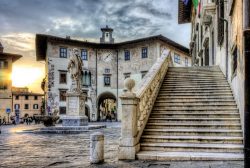 A few hundred meters from the Campo dei Miracoli do not miss this wonderful square, which takes its name from the presence of the headquarters of the Order of the Knights of Santo Stefano (commissioned by the Grand Duke Cosimo I de 'Medici). For centuries it was the place of civil power and is currently known above all for the presence of the Normal School of Pisa, housed in the Palazzo della Carovana. The Church of Santo Stefano was built by Giorgio Vasari, inside is the painting of the Stoning of Saint Stephen to which is added the Nativity of Christ by Bronzino. At the center of the square is the statue of Cosimo I as Grand Master of the Order.
A few hundred meters from the Campo dei Miracoli do not miss this wonderful square, which takes its name from the presence of the headquarters of the Order of the Knights of Santo Stefano (commissioned by the Grand Duke Cosimo I de 'Medici). For centuries it was the place of civil power and is currently known above all for the presence of the Normal School of Pisa, housed in the Palazzo della Carovana. The Church of Santo Stefano was built by Giorgio Vasari, inside is the painting of the Stoning of Saint Stephen to which is added the Nativity of Christ by Bronzino. At the center of the square is the statue of Cosimo I as Grand Master of the Order.
Address: Piazza dei Cavalieri, 56127 Pisa PI
6) The Lungarni of Pisa
 Pisa is also known for the spectacular streets that line the Arno river, interesting landmarks for tourists and important meeting points for young Pisans. They house important medieval buildings that have been transformed over the centuries. Among the various riversides, the best known is the Medici one, which houses the major historical buildings of the city, such as the Palazzo dei Medici, the Palazzo Toscanelli and the Church of San Matteo in Soarta. On the Lungarno Gambacorti there is the small and famous church of Santa Maria della Spina which inside has a splendid Madonna della Rosa by Andrea and Nino Pisano.
Pisa is also known for the spectacular streets that line the Arno river, interesting landmarks for tourists and important meeting points for young Pisans. They house important medieval buildings that have been transformed over the centuries. Among the various riversides, the best known is the Medici one, which houses the major historical buildings of the city, such as the Palazzo dei Medici, the Palazzo Toscanelli and the Church of San Matteo in Soarta. On the Lungarno Gambacorti there is the small and famous church of Santa Maria della Spina which inside has a splendid Madonna della Rosa by Andrea and Nino Pisano.
On June 16th, coinciding with the celebrations of the Patron Saint San Ranieri, do not miss the Luminara with the Arno river, which is illuminated by dozens of mg of flames that enhance the outlines of all the buildings, creating a play of light and color.
Address: Lungarni / Ponte di mezzo, 56127 Pisa PI
7) The ancient Pisan Walls
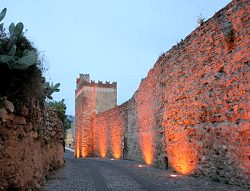 The walls of Pisa were the walls of the city of Pisa and are the oldest example of almost completely preserved city walls in Italy.
The walls of Pisa were the walls of the city of Pisa and are the oldest example of almost completely preserved city walls in Italy.
At least three walls are ascertained, one Roman, one high medieval and the last built at the time of the Republic of Pisa. Largely still present, they surround the historic center of the city and can be partially visited by 4 ascent points for a fascinating journey of about 3 km. Information on Muradipisa.it
8) The Museum of the Ancient Ships of Pisa
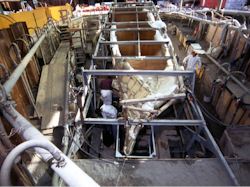 In December 1998, during the works for the construction of a building at the Pisa San Rossore station, a site of exceptional importance was discovered: it was the crossing point of a canal of the Pisan centuriation with the course of the Serchio river where, following a series of disastrous floods, sank at least 30 boats.
In December 1998, during the works for the construction of a building at the Pisa San Rossore station, a site of exceptional importance was discovered: it was the crossing point of a canal of the Pisan centuriation with the course of the Serchio river where, following a series of disastrous floods, sank at least 30 boats.
The boats, including transport ships and river boats, were found to be perfectly preserved, thanks to the particular situation of complete lack of oxygen and the presence of underground aquifers. The exceptional discovery has led to talk of a Pompeii in a maritime version.
The museum, in addition to the recovered ships, houses 800 exhibits divided into 8 sections relating to the history of trade and navigation routes of Pisa and the Mediterranean. Information on Navidipisa.it
Address: Lungarno Ranieri Simonelli, 16, 56126 Pisa PI
9) Botanical Garden with Museum
 Founded in 1543 by the naturalist, doctor and botanist Luca Ghini (1490-1556), it is the first university botanical garden in the world.
Founded in 1543 by the naturalist, doctor and botanist Luca Ghini (1490-1556), it is the first university botanical garden in the world.
Originally built on the banks of the Arno River, it was moved to its current location in 1591 and then gradually expanded to its current size of about two hectares. It hosts plants from the five continents: succulents from the African and American deserts; aromatic plants from the Mediterranean scrub; species from the Tuscan marshes; numerous centuries-old trees and many others.Information on ortomuseobot.sma.unipi.it
Address: Via Luca Ghini, 13, 56126 Pisa PI
10) The Murales of Tuttomondo
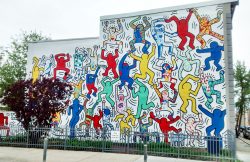 The American painter and writer Keith Haring, left to the city of Pisa an extraordinary work of art, or the mural "Tuttomondo", painted on the back fašade of the convent of the friars "Servi di Maria" of the church of S. Antonio (near the Central Station).
The American painter and writer Keith Haring, left to the city of Pisa an extraordinary work of art, or the mural "Tuttomondo", painted on the back fašade of the convent of the friars "Servi di Maria" of the church of S. Antonio (near the Central Station).
A few months later Haring died and this mural is one of his last works. The idea came to him in New York after a chance meeting with a Pisan student, the characters that animate the murals are 30, stuck like a puzzle and each represents an aspect of a peaceful world.
Address: Via Riccardo Zandonai, 56125 Pisa PI
11) Borgo stretto and Borgo largo
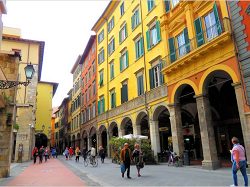 Passing through the historic center of Pisa, go past Borgo narrow, or "il borgo", as the Pisans call it. It is one of the most characteristic streets of the center, with arcades, shops, coffee tables and of course the shops for quality shopping. Along the way, buildings dating back to the 14th and 15th centuries intersect, forming the nucleus of ancient Pisa: here the families of nobles and merchants competed to build the most beautiful and attractive building. The narrow Borgo road leads to the Ponte di Mezzo, the famous bridge over the Arno river which has become famous as it annually hosts the re-enacting combat of the 'Gioco del Ponte', in which teams of full-bodied fighters challenge each other in an attempt to push a medieval cart to the side adverse.
Passing through the historic center of Pisa, go past Borgo narrow, or "il borgo", as the Pisans call it. It is one of the most characteristic streets of the center, with arcades, shops, coffee tables and of course the shops for quality shopping. Along the way, buildings dating back to the 14th and 15th centuries intersect, forming the nucleus of ancient Pisa: here the families of nobles and merchants competed to build the most beautiful and attractive building. The narrow Borgo road leads to the Ponte di Mezzo, the famous bridge over the Arno river which has become famous as it annually hosts the re-enacting combat of the 'Gioco del Ponte', in which teams of full-bodied fighters challenge each other in an attempt to push a medieval cart to the side adverse.
Address: Borgo stretto, 56127 Pisa PI
12) The coast and the Beaches
 Just 20 km from the city you can appreciate the Pisan coast, which extends from Marina di Vecchiano, near the mouth of the Serchio river, up to Livorno. The Pisan coast is famous for its well-crowded and served beaches of Marina di Pisa and Tirrenia (and for its nightlife) and for its tourist port, as well as for the lesser known beaches of Marina di Vecchiano and Calambrone. From the city center (Sesta Porta, near the train station) there is a bus connection to reach the coast in less than half an hour.
Just 20 km from the city you can appreciate the Pisan coast, which extends from Marina di Vecchiano, near the mouth of the Serchio river, up to Livorno. The Pisan coast is famous for its well-crowded and served beaches of Marina di Pisa and Tirrenia (and for its nightlife) and for its tourist port, as well as for the lesser known beaches of Marina di Vecchiano and Calambrone. From the city center (Sesta Porta, near the train station) there is a bus connection to reach the coast in less than half an hour.
Address: Marina di Pisa, 56128 Pisa PI
What to eat in Pisa
 The Pisan gastronomy is similar to the Tuscan one, but for some it is more appreciable, with more abundant and spicy courses. To taste typical frog soup, the white bean soup of San Michele or the bavettine on fish, in addition to grilled cod, boiled spider fish and sweet and sour stockfish. Do not miss the game, in particular pheasant, wild boar or wild rabbit meat. Also famous is the pesto from Pisa, which differs from the Genoese one due to the presence of pine nuts. To top it off, taste the famous' Torta Co 'Bischeri', the most typical and widespread dessert of the Pisan gastronomy.
The Pisan gastronomy is similar to the Tuscan one, but for some it is more appreciable, with more abundant and spicy courses. To taste typical frog soup, the white bean soup of San Michele or the bavettine on fish, in addition to grilled cod, boiled spider fish and sweet and sour stockfish. Do not miss the game, in particular pheasant, wild boar or wild rabbit meat. Also famous is the pesto from Pisa, which differs from the Genoese one due to the presence of pine nuts. To top it off, taste the famous' Torta Co 'Bischeri', the most typical and widespread dessert of the Pisan gastronomy.
 When we think of Pisa we refer to its leaning tower, but it is only one of the many monuments and places to visit offered by the beautiful Tuscan city. The famous Piazza del Duomo contains, in a complex unique in the world and precisely for this reason defined the 'Campo dei Miracoli', the main monuments of the city: the Tower, the Duomo, the Baptistery and the Campo Santo.
When we think of Pisa we refer to its leaning tower, but it is only one of the many monuments and places to visit offered by the beautiful Tuscan city. The famous Piazza del Duomo contains, in a complex unique in the world and precisely for this reason defined the 'Campo dei Miracoli', the main monuments of the city: the Tower, the Duomo, the Baptistery and the Campo Santo.Moving slightly, however, you can discover other artistic wonders that make it one of the most beautiful cities of art in Italy.
Buildings, monuments and museums contribute to keeping alive the memory of a past in which Pisa was a Maritime Republic and undisputed Mediterranean and commercial mistress (with particular reference to the Crusades in the Holy Land).
1) The Leaning Tower of Pisa
 Emblem of the city of Pisa due to its characteristic slope, the Tower is the most famous monument of Piazza del Duomo. Built between the 12th and 14th centuries, the Tower hangs because the land has already given way in the early stages of construction and has remained so since then thanks to complex consolidation systems. The Tower of Pisa has been proposed as one of the seven wonders of the modern world, to visit it is recommended to book tickets online in advance.
Emblem of the city of Pisa due to its characteristic slope, the Tower is the most famous monument of Piazza del Duomo. Built between the 12th and 14th centuries, the Tower hangs because the land has already given way in the early stages of construction and has remained so since then thanks to complex consolidation systems. The Tower of Pisa has been proposed as one of the seven wonders of the modern world, to visit it is recommended to book tickets online in advance.Address: Piazza del Duomo, 56126 Pisa PI
Tickets: Tiqets.com
2) The Cathedral of Santa Maria Assunta in Pisa
 The Cathedral of Pisa is dedicated to Santa Maria Assunta and is a significant example of Romanesque art. It was designed by the architect Buscheto merging elements of Norman, Byzantine and early Christian art, anticipating the Florentine Renaissance. Its construction began in 1064, coinciding with the Basilica of San Marco in Venice, in a sort of competition for the most beautiful and majestic place.
The Cathedral of Pisa is dedicated to Santa Maria Assunta and is a significant example of Romanesque art. It was designed by the architect Buscheto merging elements of Norman, Byzantine and early Christian art, anticipating the Florentine Renaissance. Its construction began in 1064, coinciding with the Basilica of San Marco in Venice, in a sort of competition for the most beautiful and majestic place.Address: Piazza del Duomo, 56126 Pisa PI
3) The Baptistery of Pisa
 Also in Piazza del Duomo it is possible to appreciate the Baptistery, whose construction began in 1153. The largest baptistery in Italy was designed by the architect Diotisalvi. The external dome covers only the inner circle of the pillars and probably due to the lack of money is made up of different materials (red tiles and lead plates); for the same reason the ceiling does not have all the frescoes foreseen in the original project.
Also in Piazza del Duomo it is possible to appreciate the Baptistery, whose construction began in 1153. The largest baptistery in Italy was designed by the architect Diotisalvi. The external dome covers only the inner circle of the pillars and probably due to the lack of money is made up of different materials (red tiles and lead plates); for the same reason the ceiling does not have all the frescoes foreseen in the original project.Address: Piazza del Duomo, 56126 Pisa PI
4) The Camposanto Monumentale of Pisa
 The last wonder of the 'Campo dei Miracoli' is the Monumental Cemetery, a sacred place because the crusaders brought here the holy land taken on Mount Golgotha, located near Jerusalem. Here the most illustrious characters are buried together with works of art from various periods including the Etruscan, Roman and medieval ages. The bombings of the Second World War caused damage to the frescoes and then the laborious restoration work began, partially still in progress.
The last wonder of the 'Campo dei Miracoli' is the Monumental Cemetery, a sacred place because the crusaders brought here the holy land taken on Mount Golgotha, located near Jerusalem. Here the most illustrious characters are buried together with works of art from various periods including the Etruscan, Roman and medieval ages. The bombings of the Second World War caused damage to the frescoes and then the laborious restoration work began, partially still in progress.Address: Piazza del Duomo, 56126 Pisa PI
5) Piazza dei Cavalieri in Pisa
 A few hundred meters from the Campo dei Miracoli do not miss this wonderful square, which takes its name from the presence of the headquarters of the Order of the Knights of Santo Stefano (commissioned by the Grand Duke Cosimo I de 'Medici). For centuries it was the place of civil power and is currently known above all for the presence of the Normal School of Pisa, housed in the Palazzo della Carovana. The Church of Santo Stefano was built by Giorgio Vasari, inside is the painting of the Stoning of Saint Stephen to which is added the Nativity of Christ by Bronzino. At the center of the square is the statue of Cosimo I as Grand Master of the Order.
A few hundred meters from the Campo dei Miracoli do not miss this wonderful square, which takes its name from the presence of the headquarters of the Order of the Knights of Santo Stefano (commissioned by the Grand Duke Cosimo I de 'Medici). For centuries it was the place of civil power and is currently known above all for the presence of the Normal School of Pisa, housed in the Palazzo della Carovana. The Church of Santo Stefano was built by Giorgio Vasari, inside is the painting of the Stoning of Saint Stephen to which is added the Nativity of Christ by Bronzino. At the center of the square is the statue of Cosimo I as Grand Master of the Order.Address: Piazza dei Cavalieri, 56127 Pisa PI
6) The Lungarni of Pisa
 Pisa is also known for the spectacular streets that line the Arno river, interesting landmarks for tourists and important meeting points for young Pisans. They house important medieval buildings that have been transformed over the centuries. Among the various riversides, the best known is the Medici one, which houses the major historical buildings of the city, such as the Palazzo dei Medici, the Palazzo Toscanelli and the Church of San Matteo in Soarta. On the Lungarno Gambacorti there is the small and famous church of Santa Maria della Spina which inside has a splendid Madonna della Rosa by Andrea and Nino Pisano.
Pisa is also known for the spectacular streets that line the Arno river, interesting landmarks for tourists and important meeting points for young Pisans. They house important medieval buildings that have been transformed over the centuries. Among the various riversides, the best known is the Medici one, which houses the major historical buildings of the city, such as the Palazzo dei Medici, the Palazzo Toscanelli and the Church of San Matteo in Soarta. On the Lungarno Gambacorti there is the small and famous church of Santa Maria della Spina which inside has a splendid Madonna della Rosa by Andrea and Nino Pisano.On June 16th, coinciding with the celebrations of the Patron Saint San Ranieri, do not miss the Luminara with the Arno river, which is illuminated by dozens of mg of flames that enhance the outlines of all the buildings, creating a play of light and color.
Address: Lungarni / Ponte di mezzo, 56127 Pisa PI
7) The ancient Pisan Walls
 The walls of Pisa were the walls of the city of Pisa and are the oldest example of almost completely preserved city walls in Italy.
The walls of Pisa were the walls of the city of Pisa and are the oldest example of almost completely preserved city walls in Italy.At least three walls are ascertained, one Roman, one high medieval and the last built at the time of the Republic of Pisa. Largely still present, they surround the historic center of the city and can be partially visited by 4 ascent points for a fascinating journey of about 3 km. Information on Muradipisa.it
8) The Museum of the Ancient Ships of Pisa
 In December 1998, during the works for the construction of a building at the Pisa San Rossore station, a site of exceptional importance was discovered: it was the crossing point of a canal of the Pisan centuriation with the course of the Serchio river where, following a series of disastrous floods, sank at least 30 boats.
In December 1998, during the works for the construction of a building at the Pisa San Rossore station, a site of exceptional importance was discovered: it was the crossing point of a canal of the Pisan centuriation with the course of the Serchio river where, following a series of disastrous floods, sank at least 30 boats.The boats, including transport ships and river boats, were found to be perfectly preserved, thanks to the particular situation of complete lack of oxygen and the presence of underground aquifers. The exceptional discovery has led to talk of a Pompeii in a maritime version.
The museum, in addition to the recovered ships, houses 800 exhibits divided into 8 sections relating to the history of trade and navigation routes of Pisa and the Mediterranean. Information on Navidipisa.it
Address: Lungarno Ranieri Simonelli, 16, 56126 Pisa PI
9) Botanical Garden with Museum
 Founded in 1543 by the naturalist, doctor and botanist Luca Ghini (1490-1556), it is the first university botanical garden in the world.
Founded in 1543 by the naturalist, doctor and botanist Luca Ghini (1490-1556), it is the first university botanical garden in the world.Originally built on the banks of the Arno River, it was moved to its current location in 1591 and then gradually expanded to its current size of about two hectares. It hosts plants from the five continents: succulents from the African and American deserts; aromatic plants from the Mediterranean scrub; species from the Tuscan marshes; numerous centuries-old trees and many others.Information on ortomuseobot.sma.unipi.it
Address: Via Luca Ghini, 13, 56126 Pisa PI
10) The Murales of Tuttomondo
 The American painter and writer Keith Haring, left to the city of Pisa an extraordinary work of art, or the mural "Tuttomondo", painted on the back fašade of the convent of the friars "Servi di Maria" of the church of S. Antonio (near the Central Station).
The American painter and writer Keith Haring, left to the city of Pisa an extraordinary work of art, or the mural "Tuttomondo", painted on the back fašade of the convent of the friars "Servi di Maria" of the church of S. Antonio (near the Central Station).A few months later Haring died and this mural is one of his last works. The idea came to him in New York after a chance meeting with a Pisan student, the characters that animate the murals are 30, stuck like a puzzle and each represents an aspect of a peaceful world.
Address: Via Riccardo Zandonai, 56125 Pisa PI
11) Borgo stretto and Borgo largo
 Passing through the historic center of Pisa, go past Borgo narrow, or "il borgo", as the Pisans call it. It is one of the most characteristic streets of the center, with arcades, shops, coffee tables and of course the shops for quality shopping. Along the way, buildings dating back to the 14th and 15th centuries intersect, forming the nucleus of ancient Pisa: here the families of nobles and merchants competed to build the most beautiful and attractive building. The narrow Borgo road leads to the Ponte di Mezzo, the famous bridge over the Arno river which has become famous as it annually hosts the re-enacting combat of the 'Gioco del Ponte', in which teams of full-bodied fighters challenge each other in an attempt to push a medieval cart to the side adverse.
Passing through the historic center of Pisa, go past Borgo narrow, or "il borgo", as the Pisans call it. It is one of the most characteristic streets of the center, with arcades, shops, coffee tables and of course the shops for quality shopping. Along the way, buildings dating back to the 14th and 15th centuries intersect, forming the nucleus of ancient Pisa: here the families of nobles and merchants competed to build the most beautiful and attractive building. The narrow Borgo road leads to the Ponte di Mezzo, the famous bridge over the Arno river which has become famous as it annually hosts the re-enacting combat of the 'Gioco del Ponte', in which teams of full-bodied fighters challenge each other in an attempt to push a medieval cart to the side adverse.Address: Borgo stretto, 56127 Pisa PI
12) The coast and the Beaches
 Just 20 km from the city you can appreciate the Pisan coast, which extends from Marina di Vecchiano, near the mouth of the Serchio river, up to Livorno. The Pisan coast is famous for its well-crowded and served beaches of Marina di Pisa and Tirrenia (and for its nightlife) and for its tourist port, as well as for the lesser known beaches of Marina di Vecchiano and Calambrone. From the city center (Sesta Porta, near the train station) there is a bus connection to reach the coast in less than half an hour.
Just 20 km from the city you can appreciate the Pisan coast, which extends from Marina di Vecchiano, near the mouth of the Serchio river, up to Livorno. The Pisan coast is famous for its well-crowded and served beaches of Marina di Pisa and Tirrenia (and for its nightlife) and for its tourist port, as well as for the lesser known beaches of Marina di Vecchiano and Calambrone. From the city center (Sesta Porta, near the train station) there is a bus connection to reach the coast in less than half an hour.Address: Marina di Pisa, 56128 Pisa PI
What to eat in Pisa
 The Pisan gastronomy is similar to the Tuscan one, but for some it is more appreciable, with more abundant and spicy courses. To taste typical frog soup, the white bean soup of San Michele or the bavettine on fish, in addition to grilled cod, boiled spider fish and sweet and sour stockfish. Do not miss the game, in particular pheasant, wild boar or wild rabbit meat. Also famous is the pesto from Pisa, which differs from the Genoese one due to the presence of pine nuts. To top it off, taste the famous' Torta Co 'Bischeri', the most typical and widespread dessert of the Pisan gastronomy.
The Pisan gastronomy is similar to the Tuscan one, but for some it is more appreciable, with more abundant and spicy courses. To taste typical frog soup, the white bean soup of San Michele or the bavettine on fish, in addition to grilled cod, boiled spider fish and sweet and sour stockfish. Do not miss the game, in particular pheasant, wild boar or wild rabbit meat. Also famous is the pesto from Pisa, which differs from the Genoese one due to the presence of pine nuts. To top it off, taste the famous' Torta Co 'Bischeri', the most typical and widespread dessert of the Pisan gastronomy.
Tel. (+39) 333-8730105
Mail: comfort.house.pisa@gmail.com
Codice struttura regionale: n░ 050026LTN0049
Codice CIN nazionale: n░ IT050026C2GM729MKH
Mail: comfort.house.pisa@gmail.com
Codice struttura regionale: n░ 050026LTN0049
Codice CIN nazionale: n░ IT050026C2GM729MKH
▲


 Italiano
Italiano


